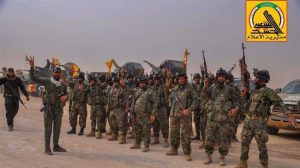The al-Hashd al-Sha’abi (Popular Mobilization Forces, or PMF) militia bases in Iraq, which are largely supported by Iran, operate separately from the Iraqi army, like reported by jns.org.
These militias were founded in response to the crisis in the Iraqi army that followed the conquest of Mosul by Islamic State in June 2014. The catalyst for their formation was an advisory opinion (al-wajib al-kifai) issued by Ayatollah Ali Sistani, a senior Iraqi Shi’ite cleric. His fatwa called for the establishment of popular mobilization forces to protect Iraq, and its Shi’ite community in particular.
In February 2016, the Iraqi parliament approved a decree ordering the PMF to integrate into Iraq’s armed forces, with its members instructed to disengage from any political party, but this order was ignored. The war against ISIS led to a triangular collaboration among the Iraqi army, the Kurdish Peshmerga forces and the PMF militias, which remained under independent Iranian command.
When the fighting came to an end, the PMF militias were faced with two alternatives: integrate into Iraq’s security forces, or disarm and integrate into Iraq’s sociopolitical system. Both were anathema to Tehran.
Elections for the 329-member Iraqi parliament were held in May 2018. The election campaign was a golden opportunity for Iran to implement its plan to turn the militias operating under its umbrella into an influential political axis in Iraq. To this end, a new political mechanism was established, called the Fatah Coalition. Led by Hadi Ameri, the coalition included representatives of the Iranian Shi’ite militias, including the Badr organization, Asa’ib Ahl al-Haq, Kata’ib Hezbollah and Kata’ib al-Imam Ali.
Once the votes were counted, the Fatah Coalition stood in second place with 48 seats in the new parliament. The Saairun Alliance, led by Muqtada al-Sadr, came in first with 54 seats. In third stood the Al-Nasr Coalition, led by Haider Abadi, with 42.
In July of this year, Iraqi Prime Minister Adel Abdul-Mahdi issued an ultimatum—against Iranian resistance—demanding that the PMF finally integrate into Iraq’s security forces. The Shi’ite militia commanders do not appear to intend to implement this directive. The Liwa al-Muntadhar militia (operating in the Kurdish region) made headlines with its refusal to be evacuated from that battle-stricken area, despite American pressure on President Barham Saleh and Prime Minister Abdul-Mahdi.
From Iran’s point of view, turning Iraq into a client state is a vital step in implementing the “axis of resistance” conceived by the leader of the revolution. This conceptual pattern rests on four dimensions:
• Penetrating through soft power; i.e., establishing cultural centers, providing welfare and Islamic guidance with the aim of recruitment and creating sympathy for Ayatollah Khomeini’s “Vilayat-e Faqih” (Governance of the Jurist) concept.
• Establishing militias functioning under the guidance of Iran’s Islamic Revolutionary Guard Corps, with the object of setting up a hybrid mechanism operating parallel to the Iraqi army.
• Investing great resources in post-war restoration, with an emphasis on telecommunications infrastructure, industrial and urban reconstruction.
• Turning the militias into a powerful political force that is actively involved in formulating foreign and domestic policy, in line with Iran’s interests.
This conceptual pattern is intended to combine the military, political, economic and—no less importantly–cultural dimensions.
Tehran’s inroads into Lebanon (through its Hezbollah proxy) have served as a springboard from which to implement the same model in Iraq, Syria and Yemen. Yet despite Iraq’s economic dependence on its neighbor to the east, the presence of Shi’ite militias under Iranian rule has been met with both domestic and foreign opposition. The recent round of attacks on the organization’s bases and warehouses has created a renewed debate about the presence of PMF militias on Iraqi soil, with voices objecting to their activities and expressing concern about the possible outcome of Iran’s violation of Iraqi sovereignty.
The attacks on the bases are seen as an attempt to disrupt Iran’s grip on Iraqi (as well as Syrian and Lebanese) territory, which Tehran needs to establish its long-sought ground corridor from the Iranian border to the Mediterranean basin.
In a move widely interpreted as a signal that Muqtada al-Sadr is under Iran’s influence, Tehran recently distributed an image of that influential cleric sitting between the supreme leader and the Quds Force commander at a ceremony marking the Islamic holiday of Ashura. The spectacle of Sadr in Iran fanned the flames of the internal argument in Iraq between supporters of the Iranian presence and those in opposition to it.
Some argue that Sadr’s presence in Iran will strengthen its sphere of influence and jeopardize Iraq’s independence. But others praise it, stating that it is natural for a Shi’ite leader to be present at ceremonies marking the holiday, which is of special significance to Shi’ite muslims. They stress that Sadr enjoys good relations with all neighboring countries and claim that leaders throughout the region value his views.
It is worth noting that Sadr recently announced that he would implement the integration of the Sarayat al-Salam militia into the Iraqi military apparatus, in accordance with the ultimatum issued by the Iraqi prime minister. This stood in sharp contradiction to the position of Shi’ite militia commanders operating under Iranian auspices, who oppose the move.
Ever since the establishment of the Islamic Republic in 1979, the regime has worked tirelessly to promote its revolutionary ideology throughout the Muslim world. The disintegration of Iraq following the removal of Saddam Hussein, in combination with Iraq’s demographic structure, provides fertile ground on which to advance this worldview.
The Iraqi prime minister, who faces a great challenge in integrating the militias, stands between the hammer and the anvil. On one side is Iran, which strives to exploit Iraq’s structural weaknesses to boost its leverage. On the other are the United States and, to some extent, Saudi Arabia and Israel, which hope to counter Tehran’s efforts to transform Iraq into a client state.



